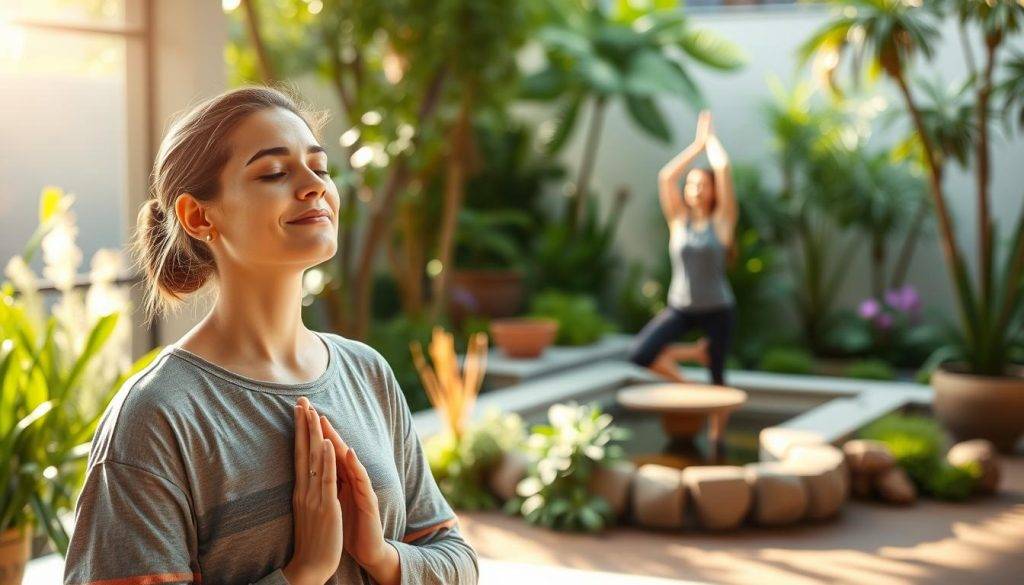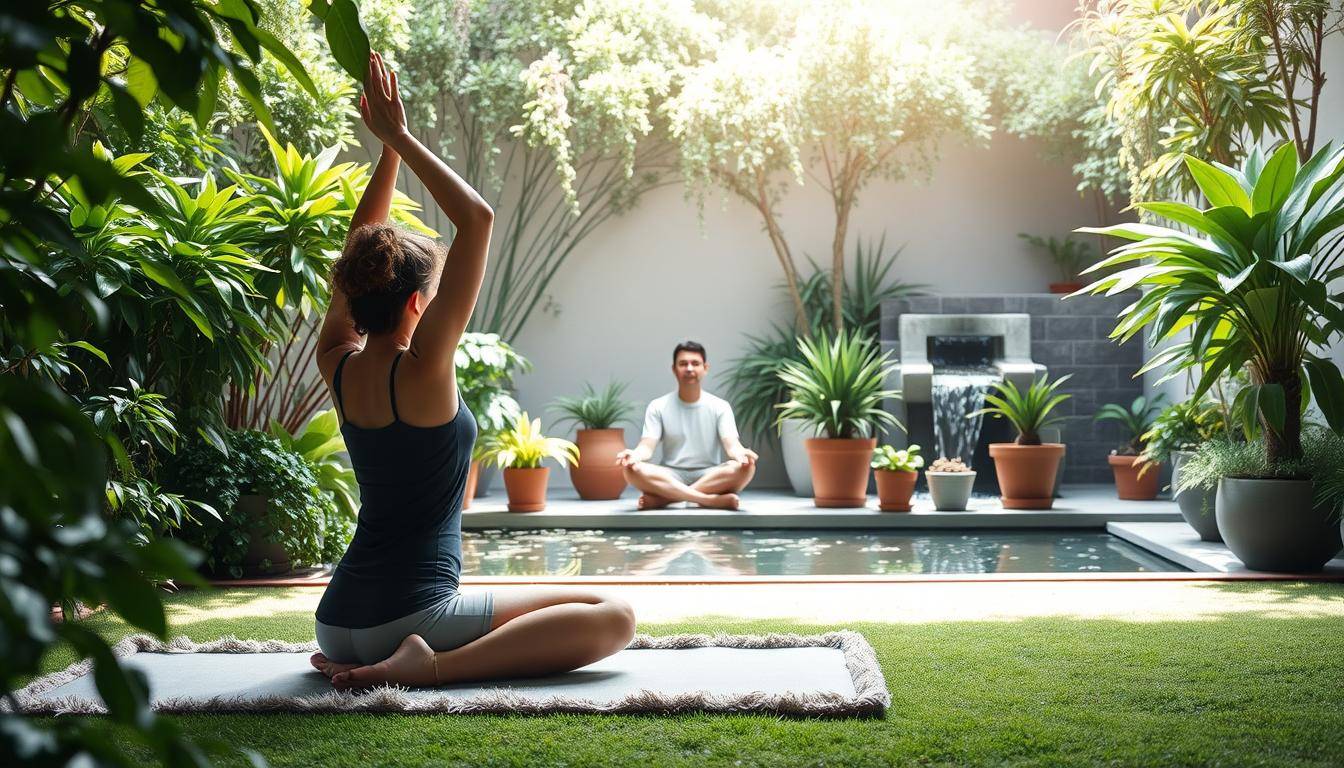“There is no way to peace—peace is the way.” – Thich Nhat Hanh
In a world where stress often overshadows serenity, a transformative practice merges ancient wisdom with modern neuroscience. Developed in the 1960s by neuropsychiatrist Alfonso Caycedo, this method bridges Eastern mindfulness traditions and Western psychology. It focuses on harmonizing physical sensations, mental clarity, and emotional resilience through accessible techniques.
Unlike conventional relaxation methods, this approach actively engages both body and mind. Breathing exercises, guided visualizations, and gentle movements create immediate shifts in awareness. People learn to reprogram stress responses while cultivating focus—a skill applicable during work deadlines or personal challenges.
The practice’s adaptability explains its global adoption across healthcare, education, and corporate training. Athletes use it to enhance performance, while educators apply its principles to improve concentration. By addressing multiple aspects of wellness simultaneously, it offers practical tools for modern life without requiring hours of meditation.
Key Takeaways
- Blends 60+ years of neuroscience with Eastern mindfulness traditions
- Uses dynamic body-mind techniques for real-world stress management
- Teaches adaptable skills for immediate use in daily challenges
- Supports goals from pain relief to peak performance
- Recognized by healthcare and business leaders alike
Understanding Sophrology: Origins and Philosophy
When traditional psychiatric methods fell short, Dr. Alfonso Caycedo pioneered a new path. In 1960, this Madrid-based neuropsychiatrist began exploring consciousness studies to improve patients’ lives. His work led to creating a structured “study of awareness in harmony” – later defined as sophrology.
History and Development by Alfonso Caycedo
Caycedo spent four decades developing his signature approach. Frustrated by harsh psychiatric treatments, he designed 12 progressive levels of training. These combined breathing exercises with mental focus techniques. By 2000, his Caycedo Dynamic Relaxation method offered a complete system for balancing body and mind.

Eastern and Western Influences
The method’s power comes from blending ancient wisdom with modern science. Caycedo’s research trips to Asia exposed him to Japanese Zen practices and yoga traditions. He fused these with Western psychology principles from thinkers like Ludwig Binswanger.
“True healing begins when we understand the dialogue between body and consciousness.”
| Aspect | Eastern Influence | Western Contribution |
|---|---|---|
| Philosophical Roots | Zen mindfulness | Existential psychology |
| Techniques | Meditation postures | Clinical relaxation methods |
| Research Approach | Ancient scriptures | Neuroscientific studies |
Today, Caycedo’s daughter Natalia continues refining the practice. This ensures the method stays relevant while keeping its core focus: helping people achieve balance through structured consciousness exploration.
Exploring Sophrology Techniques: From Breathwork to Visualization
Modern wellness practices often focus on quick fixes, but some methods offer layered tools for lasting change. These approaches combine physical engagement with mental training, creating pathways to manage stress while building resilience.
Dynamic Relaxation and Movement Practices
Central to this method are dynamic relaxation techniques that teach the body to recognize tension patterns. Practitioners alternate between contracting muscle groups and releasing them—a physical metaphor for managing life’s pressures. This contrast helps reprogram automatic stress responses.
The practice divides the body into five interconnected systems during scanning exercises. This structure allows focused attention on specific areas—from shoulders to feet—enhancing sensory awareness. Sessions might involve seated stretches or standing movements, making techniques adaptable for various fitness levels.
Mindfulness and Body Awareness Exercises
Breathwork forms the foundation here. Controlled inhalation-exhalation cycles act as anchors during challenging moments. One exercise involves visualizing air moving through colored zones in the body, merging mind focus with physiological calm.
Advanced methods incorporate elements of hypnosis without inducing trance states. Instead, practitioners guide themselves through vivid mental rehearsals—preparing for job interviews or difficult conversations through detailed visualization. This builds confidence while maintaining conscious control.
Regular exercises cultivate non-judgmental observation of thoughts and sensations. Over time, this develops mental flexibility—the ability to acknowledge stressors without being overwhelmed by them. As one practitioner notes: “It’s like having an internal toolkit that travels wherever life takes you.”
Harnessing Sophrology in Everyday Life
Modern challenges demand tools that adapt as quickly as life changes. This approach turns fleeting calm into sustainable resilience through techniques designed for real-world application. Whether facing tight deadlines or personal conflicts, its methods offer immediate pathways to regain control.

Integrating Techniques for Stress and Tension Relief
Breath becomes an anchor during chaotic moments. A CEO might use quick muscle relaxation before investor meetings—tensing shoulders for five seconds, then releasing with a focused exhale. This resets the nervous system, melting accumulated stress.
| Scenario | Technique | Benefit |
|---|---|---|
| Work Pressure | 4-7-8 Breathing | Instant focus boost |
| Creative Blocks | Color Visualization | Mental clarity |
| Relationship Tension | Body Scanning | Emotional balance |
Customizing Practices for Personal Growth
One parent uses morning affirmations to approach childcare with patience. An artist combines movement exercises with idea generation. “It’s not about changing who you are—it’s about unlocking what’s already there,” notes a certified instructor.
Weekly 10-minute sessions build autonomy over time. Users report sharper decision-making and unexpected serenity during crises. The development of these skills creates ripple effects—better sleep fuels creativity, which enhances professional performance.
The Science and Benefits Behind Sophrology
Emerging research bridges ancient practices with modern medical needs, revealing measurable improvements in health outcomes. Studies now validate how mind-body techniques influence both physical symptoms and emotional resilience.
Research Insights on Pain and Anxiety Management
A 2018 study of 60 cancer patients undergoing radiation therapy showed striking results. Those practicing relaxation methods reported 40% less pain and 35% lower anxiety levels compared to untreated groups. “Our findings suggest these techniques could redefine supportive care,” noted lead researchers.
Childbirth preparation programs blending breathing training with pelvic exercises yielded equally compelling data. Participants experienced 28% fewer postpartum complications and newborns with 15% higher birth weights. This synergy of traditional and modern approaches demonstrates versatile therapy applications.
Wellness Benefits Across Different Life Stages
From prenatal care to retirement years, these methods adapt to evolving needs. Expectant mothers report better sleep quality, while seniors show improved concentration during memory exercises. One nurse practitioner observes: “Patients aren’t just managing symptoms—they’re rebuilding their relationship with their bodies.”
Ongoing trials explore applications for chronic conditions like migraines and arthritis. With 72% of users in a recent survey reporting sustained wellness improvements, the evidence grows clearer: intentional mind-body practices create ripple effects through every life chapter.
Practical Approaches: Exercises and Daily Practice
Mastering daily calm begins with accessible tools that fit seamlessly into busy schedules. These methods transform ordinary moments into opportunities for renewal—no special equipment or hours of training required.

Simple Practices to Release Tension
Start by scanning your body like a diagnostic tool. Notice where shoulders hunch or jaws clench. One office worker shares: “I release neck tension by imagining dark smoke leaving my muscles during exhales—it’s like hitting a reset button.”
Try this three-step sequence before bed:
- Press heels into the mattress while inhaling
- Release pressure as you exhale slowly
- Visualize tension as colored mist leaving through fingertips
Using Breath and Visualization for Calm
Place both hands on your abdomen. Feel them rise like ocean waves during inhales. A teacher explains: “This belly-breathing trick helps me stay composed during parent conferences.” Extend exhales gradually—like letting air escape from a balloon—to activate natural relaxation.
| Situation | Breath Pattern | Visual Focus |
|---|---|---|
| Work Stress | 4-count inhale, 6-count exhale | Imagining cool blue light |
| Sleep Prep | Equal 5-5 rhythm | Feeling bedsheets’ texture |
Consistent practice builds what experts call “calm muscle memory.” Whether waiting in traffic or prepping presentations, these techniques offer immediate pathways to peace. The key lies in repetition—not perfection—creating sustainable habits that support overall wellness.
How to Find a Qualified Sophrologist
Choosing the right guide transforms practice into progress. Qualified professionals help tailor techniques to your unique needs—whether managing work stress or enhancing personal growth. Start by verifying certifications through recognized bodies like the International Sophrology Relational Network (ISRN) or American Sophrology Registry (ASR).
Local and Online Resources for Expert Guidance
Local practitioners often offer in-person sessions at wellness centers or private studios. Search directories using terms like “certified sophrologist near me” to find specialists. Many combine private coaching with group classes, letting you experience both personalized and community-based learning.
Virtual platforms expand access to top-tier training. Websites like SophroAcademy host live-streamed sessions and on-demand courses. Look for instructors who balance technical expertise with real-life application skills—those who’ve worked in healthcare or education often bring deeper insight.
Free introductory workshops help assess compatibility. Ask about their approach to group dynamics or individual coaching styles. “A good match feels like teamwork—they listen as much as they teach,” notes New York-based instructor Mara Simmons.
Remember: quality training prioritizes sustainable results over quick fixes. Whether through local meetups or digital sessions, the right sophrologist becomes a partner in navigating life’s complexities with renewed clarity.
FAQ
Who developed sophrology and why?
Psychiatrist Alfonso Caycedo created sophrology in the 1960s to bridge Western psychology with Eastern mindfulness practices. His goal was to help patients manage pain and anxiety through structured mind-body techniques.
How does dynamic relaxation differ from regular meditation?
Dynamic relaxation combines gentle movements with breath awareness to release tension, while traditional meditation often focuses on stillness. This method engages both body and mind for deeper stress relief.
Can these techniques help with chronic pain?
Studies show that controlled breathing and body scanning – core practices in Caycedo’s method – reduce pain perception by calming the nervous system. Many users report improved pain management after consistent practice.
What makes this approach suitable for busy professionals?
Short sessions (5-15 minutes) using visualization or targeted breathing can be done anywhere. These tools help professionals reset focus, manage workplace stress, and maintain emotional balance during demanding days.
Are there risks to practicing without a trained guide?
While basic exercises like diaphragmatic breathing are safe solo, working with a certified sophrologist ensures proper technique – especially when addressing specific issues like trauma or severe anxiety. Reputable directories like the International Sophrology Federation list qualified practitioners.
How soon can someone expect results?
Most notice reduced tension within 2-3 weeks of daily practice. Long-term benefits like improved sleep or emotional resilience typically emerge after 8-12 weeks of consistent work, as shown in a 2021 University of Geneva study.
Can older adults benefit from these methods?
Yes – low-impact movements and seated mindfulness exercises are ideal for seniors. Research in the Journal of Aging Studies highlights improved balance and cognitive function in older practitioners using adapted techniques.




























































